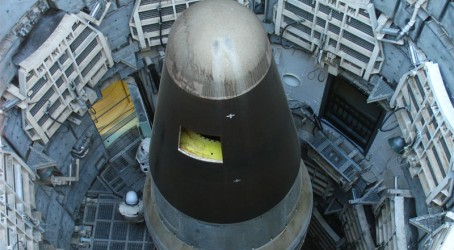What do space weather and high-altitude nuclear detonations have in common? The answer is that they both have the potential to cause disruption to electrical and electronic systems here on earth. Some in the US and UK governmental elites are saying we are not adequately protected against this threat, which could be exploited by terrorists or countries with nuclear weapons.
Solar storms – such as the most powerful one of 1859, known as the Carrington Event – and weapons such as nuclear devices generate electromagnetic pulses (EMPs), or bursts of electromagnetic radiation. These, it is feared, have the potential to play havoc with the electricity grid and other infrastructure.
The warnings come from recent history, especially the Cold War. The US and Russia carried out experiments in which nuclear weapons were detonated at high altitude in the 1960s. It had long been understood that such weapons would generate electromagnetic pulses, but scientists and engineers were unsure of the extent of the problem for infrastructure on earth.
Tests by the US in 1962 showed that a high-altitude electromagnetic pulse (HEMP) generated by detonating a nuclear device 250 miles above the Pacific could cause damage to electrical systems in Hawaii, where streetlights went out and burglar alarms were set off.
Scientists hypothesised in the wake of this test that the damage EMPs would produce might be relatively insignificant. But they came to understand that if the Hawaii experiment had been repeated over the continental US an EMP of greater scale – perhaps six times as big – might have been produced owing to differences in the earth’s magnetic field at higher latitudes.
The fear now is that with our increased dependence on microelectronics such an event would mean widespread damage to the grid and devices relying on it.
In Britain, the defence select committee produced a report this year highlighting the threat, a sign that MPs are taking it seriously. And in the US there is a vociferous movement backing proposed legislation that would enshrine in law the necessity of protecting the electricity grid against EMP attack.
The legislation, known as the Shield Act – Secure High Voltage for Electricity from Lethal Damage Act – has yet to be passed by the House of Representatives. It’s backed by Trent Franks, a Republican representative for Arizona, who claims that potential casualties from a sustained failure of the US electricity grid could be more than 60% of the population.
He says: “The current strategy for recovery from a failure of the electric grid leaves us ill-prepared to respond to a man-made or naturally occurring EMP event that would potentially result in damage to vast numbers of components nearly simultaneously over an unprecedented geographic scale.”
The effects of a HEMP device depend on many factors, including the altitude of the detonation, energy yield, gamma-ray output, interactions with the earth’s magnetic field, and electromagnetic shielding of targets. It is this shielding that those worried about the EMP threat are keen to promote. At engineering companies such as Liverpool’s MPE, HEMP filter designs for safeguarding electrical equipment in defence and homeland security applications have been under development for a number of years.

Antoni Jan Nalborczyk, MPE’s technical director, says: “The intense electromagnetic pulse created by a high-altitude nuclear blast could disable, damage or destroy electrical power supply networks, unprotected items of electrical equipment and electrical controls for key service industries over a wide area of the earth’s surface. Any equipment containing microchips would be particularly vulnerable and could be damaged or destroyed in a fraction of a second.
“A solar flare or geomagnetic storm, over which we have no control but which will inevitably happen from time to time, could produce a similar catastrophic result. An historical example of this was the Carrington super flare of September 1859, when semiconductor electronics lay far in the future, so effects will depend on what vulnerable technology may be in existence at the time of the event.”
The House of Commons defence select committee seems to be following the lead of politicians in the US in a desire to see these issues addressed. In February it said: “The consequences of EMP events must be addressed specifically: generic civil contingency plans which address blackouts and temporary loss of electronic infrastructure caused by a range of events are not sufficient. Space weather is a global threat and may affect many regions and countries simultaneously. This means that there is scope for mutual assistance, but also that there is no safe place from which it can be assumed that help will come.
“It is time that the government began to approach this matter with the seriousness it deserves.”
The MPs added that it is “vitally important that the work of hardening UK infrastructure is begun now and carried out as a matter of urgency”. This would mean that the Ministry of Defence should share with infrastructure companies any information it has that could help to counteract the EMP threat.
A government department should take the lead in coordinating British efforts to guard against EMPs. The MPs said: “There must be a clear line of responsibility within the MoD; an appearance is given that the MoD is unwilling to take these threats seriously.”
How seriously should they be taken? The risk of a severe space weather event is regarded as being considerably more likely than a high-altitude nuclear strike, or the development and deployment of low-level EMP weapons by terrorists.
The defence select committee quoted from the National Security Strategy, which found in 2010 that: “Severe space weather, which might cause geomagnetic storms impacting the earth’s magnetosphere, has been the subject of extensive research over the past year. The likelihood of a severe space weather event is assessed to be moderate to high over the next five years, with the potential to cause damage to electrically conducting systems such as power grids, pipelines and signalling circuits.”
The biggest risk may not, then, be from other nations or rogue groups but from nature itself.